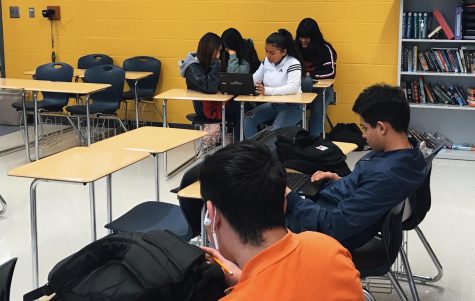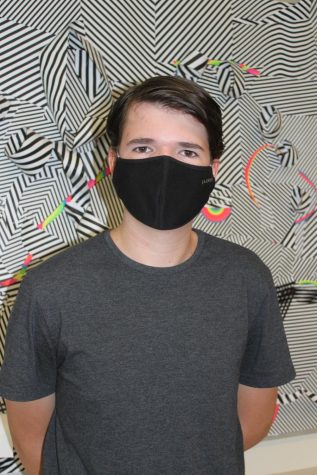Struggling to STAR: STAR Plus Comes in Second Semester
A STAR Plus student writes in their notebook in Mr. Avett’s star period.
February 6, 2020
For freshmen and sophomores at Chamblee, MAP Testing (Measures of Academic Progress) is a tedious task that students and teachers must go through throughout the year. Despite this, the adaptive test has the benefit of serving as a measure of student growth over time and as an academic benchmark. In order to help improve students with low MAP Testing scores, the administration has implemented a new program called STAR Plus.
Taking place during our school’s STAR Period, students with the lowest twenty percent of MAP Testing scores will be given a pass to go to another classroom for extra practice and instruction in either math or reading. Approximately two hundred students at Chamblee have been placed in this STAR Plus program.
English teacher Hannah Postema is coordinating STAR Plus for reading, while math teacher Mallory Clark is coordinating STAR Plus for math. Along with them, there are currently twenty-nine teachers who are instructing STAR Plus periods.
“STAR Plus is a targeted intervention program running during STAR Period, which is sort of our in-school study hall time. The idea is that we take the twenty percent of the lowest scores on MAP Testing and in math and reading,” said Postema. “That’s twenty minutes where we are working with them on improving those skills for reading or math depending on what they need.”
For each subject that a student needs improvement on their MAP Testing score in, they will attend STAR Plus two days a week during STAR Period.
“There are two reading days and two math days. Reading days are Tuesdays and Thursdays. Math days are Wednesdays and Fridays. So if you are a student who needs help in both subject areas, you are going to STAR Plus four times a week and you have Mondays free to go to other teachers for STAR Period,” said Postema.
During these STAR Plus periods, students will be going to a teacher who doesn’t teach a third period class. This is so that teachers can instruct a STAR Plus class without having to manage another class during STAR Period or have other students in the room.
“[STAR Plus students] are in any teacher who has planning during third period, that’s who you are going to. That way when you enter the room there is nobody else in there and the teachers don’t have to worry about relocating students they already have,” said Postema. “Some groups are in the cafeteria [and] some students are in the media center, but for the most part, most students are in a classroom with a classroom teacher.”
In STAR Plus, students will be working on primarily online assignments. These will utilize online learning platforms that include USA Test Prep for reading and Khan Academy for math and reading.
“It’s primarily going to be ChromeBook work. It’s primarily going to be online just to make it easier for rolling out new assignments and then also creating targeted assignments,” said Postema. For math they’ll be working on Khan Academy and whatever extra resources the teachers will do for that. [For reading,] we will be using Khan Academy, USA Test Prep and occasionally CommonLit.”
Interviewed students were generally positive about the new program, despite not knowing a lot about it at first.
“When I first heard about it, I thought it was an okay program. But learning about it and actually doing my assignments and all of that, I think it’s a great program for all of us to learn more and be more educated and all that,” said student Irvin Dorotl, who is in STAR Plus for math and reading.
Other students believe that the program is good for getting a better understanding of the material and believe it is going to be helpful throughout their subject.
“It definitely was interesting because I didn’t know that they did that type of stuff, but it is very helpful. […] I like it a lot because it gets us extra help from the teacher and more understanding of the material you’re learning. So I think it’s going to help throughout the rest of math,” said student Estella Ruyes, who is in STAR plus for math.

Students working in Ms. Postema’s room during STAR Plus.
One of the main issues with STAR Plus that has emerged this semester is low attendance to STAR Plus periods. For example, English teacher Zachary Welser reported that only five out of thirty students attended his STAR Plus period. English teacher Fred Avett also reported that only three students showed up to his first STAR Plus period.
“I have thirty on my roster. I have seen five of them. I think attendance is an issue with STAR Plus and I don’t quite know how we’re going to get that fixed as of now,” said Welser.
Possible solutions for this issue offered by Postema included better communication with students about what STAR Plus is and why it’s important for them to attend.
“I think that making sure [STAR Plus students] get their passes and maybe communicating more clearly to them what STAR Plus is and when it is. I think there is some confusion among the students. This rolled out, teachers were notified, but maybe students could have been notified better.”
Another solution to the low attendance issue mentioned by Postema was having teachers in the hallways during the STAR Period class change and administrators checking each floor.
“[We could have] teachers in the hallways just for that class change between third period and STAR Plus, encouraging those who have their STAR Plus passes to go to STAR Plus, and then admins checking out their floors; each admin is assigned a floor during STAR Plus making their rounds and sweep up any people who used the pass to get out and hang out on the back stairwell,” said Postema.
Another concern with STAR Plus is that students with low scores on both subjects in MAP Testing may need help in other classes and four days of STAR Plus takes away the STAR Period time when they could get help in their actual classes.
“The whole idea is that we need to build these skills, but they’re not having time to see their teachers in their actual classes. Then what does that do to them?” said Welser.
Some students also agree that taking away STAR Period time can impact them.
“Sometimes it can impact us, because we probably need to go somewhere else but because we have the star pass and we have to go [to STAR Plus]. It’s like ‘I can’t go because I have to see another teacher,’” said Dorotl. “That can really impact our education.”
Some students at Chamblee have also not taken MAP Testing seriously, knowing it won’t affect their grades. Postema believes that these students will test out of STAR Plus quickly due to not actually needing additional help. Every four weeks students in STAR Plus will be reevaluated with a diagnostic test to determine what areas they need more help in or to test out.
“There will be students who will quickly test out, just because they didn’t take the map test seriously and they Christmas-treed the MAP test because they know while it doesn’t affect their grade, it does affect your placement in Magnet and Gifted programs,” said Postema. “So they should take it seriously, but for whatever reason, they didn’t and they are in STAR Plus, but they don’t actually need that extra help. Unfortunately, we can’t tell that based on their scores. so those students will be weeded out fairly quickly in the first four weeks.”
With low attendance and students who didn’t take MAP Testing seriously, Welser has his own theories as to why.
“It could be either way, but I would say the odds are that kids who are showing up like they are supposed to are probably the ones that do want to do better in school,” said Welser. “I’m going to say they are actually trying to improve, while the students that skipped through and didn’t care about it are also the ones skipping STAR Plus.”
Right now, both students and teachers are adjusting to the new routine of going to STAR Plus.
“I do hope that it’s successful. […] I think once we’re in the routine of using STAR time for extra remediation and intervention with students that things will run more smoothly,” said Postema. “[For] any new initiative it does take time to get the kinks ironed out. As long as we’re […] keeping an open mind to improving it as we go with good feedback from teachers and from students.”
Teachers agree that rolling out the program was rocky in the beginning, but hope that STAR Plus benefits students who need additional help.
“I think that it’s a good idea overall. The beginning’s been a bit rocky for me, signing them up for USA Test Prep and I don’t know them at all. That’s been a little frustrating, but at the same time, everything is rocky when it starts and I’m happy we are doing something at this time to help our learners who need additional support,” said Welser. “I’m overall pro-STAR Plus, it just needs to be a bit fine-tuned as we go.”











